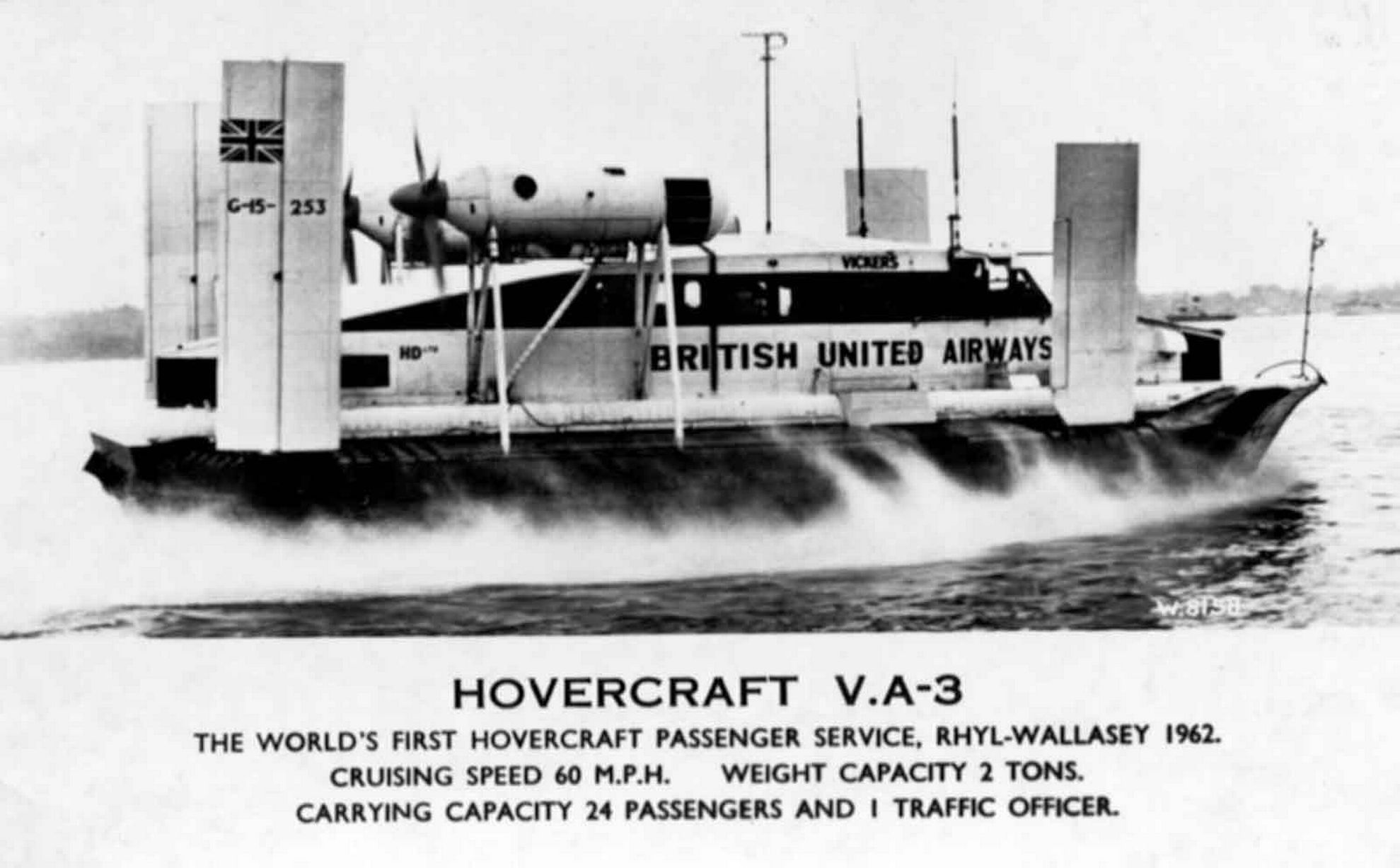
Aluminium hovercraft VA3-001, built Vickers Armstrong, South
Marston, near Swindon. Inaugural passenger service, Wirral - Rhyl, on
20 July 1962, a distance of 15 nm. Crew 2, 1 steward and maximum
passengers 24. Length 56ft, beam 27ft, draught (under way) 0ft, weight
about 12 tons, cruise speed 60 knots, two propulsion engines (Bristol
Siddley Turmo Free Turbines) and two lift engines - total 4 x 425 shp.
Operated by British United Airways. This was a trial service - intended
to last only 2 months.
When moored at Rhyl, on the night of 16 September 1962, during a
gale, broke free from moorings and subsequently damaged by contact with
sea-wall. Lifted by crane and transported back to Hampshire; it was
then further modified and developed but eventually dispersed over deep
water in the Solent around the 1970s. Details
of VA3 modifications and later history.
The direct route from Wirral to Rhyl has sandbanks that are only covered near high water, so was very well suited for a hovercraft. Initially Hoylake had been suggested as the Wirral terminus, but, after complaints by residents, that was changed to Moreton - about 100 yards from Leasowe Lighthouse - also suitable because of the flat beach at low tide. Moreton was in Wallasey borough - so that name was often given as the terminus. The plan was for six daily return services, with Rhyl harbour (Voryd) acting as the base. Passenger fare was £1.
Image of hovercraft in service

Bad weather and engine trouble meant that only on 19 of the planned 59 days was the service operational. This was partly because the hovercraft did not have skirts - so required a small wave height to hover efficiently. Also the hovercraft, when on the beach, blew up sand - which entered the engine intakes, resulting in problems.
Pathe News video of first Hovercraft service.
A storm on the night of 16-17 September, combined with a very high tide, drove the craft from its moorings at Rhyl and Rhyl lifeboat was summoned to rescue the three crew aboard. With help from shore crew, the hovercraft was then secured with lines from the shore - ending up opposite the Alexandra hospital (over a mile from Voryd harbour). Before it was secured, it was smashed against the sea wall, causing some damage. It was lifted out later on 17 September and eventually returned by coaster to Hampshire.
Report of damage to VA3. [from Liverpool Echo - Monday 17 September 1962]:
CRANES SENT FROM CITY. A decision on whether the storm-damaged
Hovercoach is to be transported from Rhyl to Birkenhead docks by road
or sea for shipment to its depot at South Marston (Wiltshire) will be
made when the underside of the craft has been inspected. This was
announced this afternoon by Vickers Armstrong officials at South
Marston. A Liverpool firm of crane-hirers received an urgent request
shortly after 5 a.m. to-day for two mobile cranes to be sent to Rhyl
to lift the Hovercoach onto the lifeboat slipway. Less than two hours
later, the two cranes, each with a 20-ton lifting capacity, had been
sent off. They were given priority travel through the Mersey Tunnel.
Watched by hundreds of people, the Hovercraft was lifted by the cranes
and lowered onto a trolly and towed 200 yards to an open space.
LASHED TO RAILINGS. The Hovercoach, lashed securely to the railings
of Rhyl's West Promenade, stood high and dry on the sands this morning
after a night of drama during which it was feared that it might become
a total loss. After the experience of Saturday night when the
Hovercoach broke from its moorings and was prevented from crashing
into the sea wall by the prompt action of the second pilot, Mr Raymond
Old, who used the propelling engines; the chief pilot, Squadron Leader
Leslie Colquhoun, decided to spend the night in the craft with Mr. Old
and another co-pilot, Mr Richard White. In the early hours of this
morning, the shore cable snapped again and the Hovercoach commenced to
drift out to sea. Squadron Leader Colquhoun signalled the coastguard
for assistance and the Rhyl lifeboat was launched. When it reached the
Hovercoach, it was about a quarter of a mile out and the crew jumped
into the lifeboat and were taken to Voryd Harbour.
ABANDONED. Meanwhile, the abandoned Hovercoach, at the mercy of a
high wind and a 32 feet tide [this is a big spring tide], lurched over
the high waves and drifted towards the promenade wall. Awaiting it,
were the lifeboat launching crew, the members of the Rhyl Lifesaving
Association and Rhyl Fire Brigade. In the windy darkness, they had
considerable difficulty in lashing the 12 ton craft to the wall but were
helped in their task by the lights from the headlamps of dozens of cars
which were directed towards the operation.